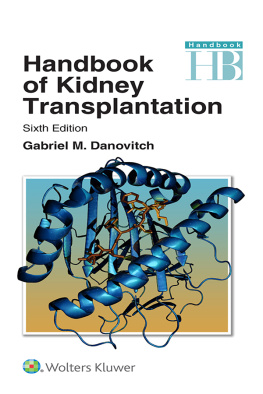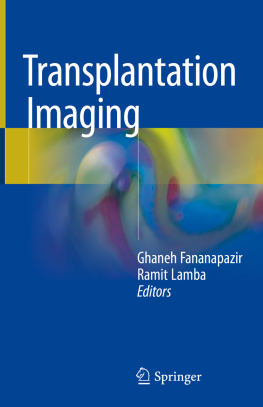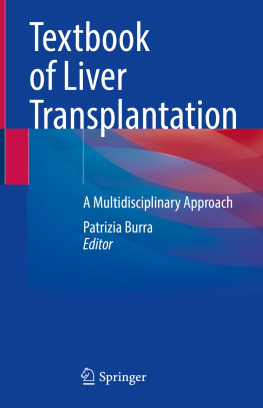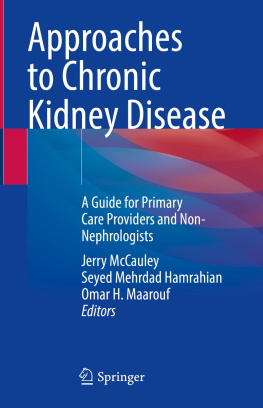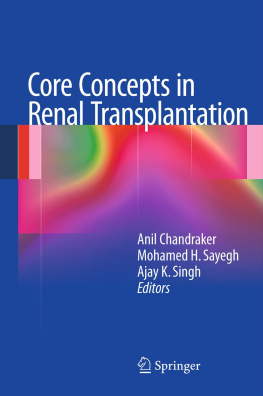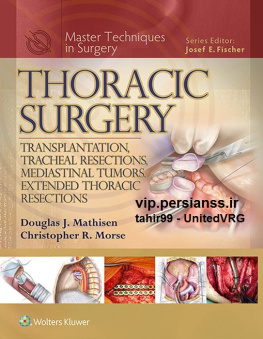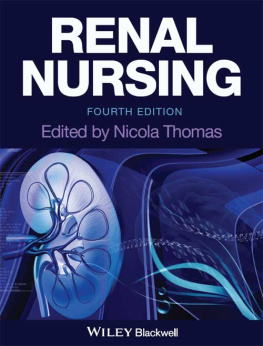Sir, Peter J. Morris, MD, PhD, FRS, FRCS
Director, Centre for Evidence in Transplantation, Royal College of Surgeons of England, London, UK
Stuart J. Knechtle, MD, FACS
Copyright

2014, Elsevier Inc. All rights reserved.
First edition 1979
Second edition 1984
Third edition 1988
Fourth edition 1994
Fifth edition 2001
Sixth edition 2008
No part of this publication may be reproduced or transmitted in any form or by any means, electronic or mechanical, including photocopying, recording, or any information storage and retrieval system, without permission in writing from the publisher. Details on how to seek permission, further information about the Publishers permissions policies and our arrangements with organizations such as the Copyright Clearance Center and the Copyright Licensing Agency, can be found at our website: www.elsevier.com/permissions.
This book and the individual contributions contained in it are protected under copyright by the Publisher (other than as may be noted herein).
Notices
Knowledge and best practice in this field are constantly changing. As new research and experience broaden our understanding, changes in research methods, professional practices, or medical treatment may become necessary.
Practitioners and researchers must always rely on their own experience and knowledge in evaluating and using any information, methods, compounds, or experiments described herein. In using such information or methods they should be mindful of their own safety and the safety of others, including parties for whom they have a professional responsibility.
With respect to any drug or pharmaceutical products identified, readers are advised to check the most current information provided (i) on procedures featured or (ii) by the manufacturer of each product to be administered, to verify the recommended dose or formula, the method and duration of administration, and contraindications. It is the responsibility of practitioners, relying on their own experience and knowledge of their patients, to make diagnoses, to determine dosages and the best treatment for each individual patient, and to take all appropriate safety precautions.
To the fullest extent of the law, neither the Publisher nor the authors, contributors, or editors, assume any liability for any injury and/or damage to persons or property as a matter of products liability, negligence or otherwise, or from any use or operation of any methods, products, instructions, or ideas contained in the material herein.
A catalogue record for this book is held in the British Library.
ISBN: 9781455740963
Ebook ISBN: 9781455774050

Printed in China
Last digit is the print number: 9 8 7 6 5 4 3 2 1
Video Table of Contents
Access all videos online at expertconsult.com. See inside front cover for activation code.
Ch 02 clip 01 Formation of an immune synapse
Dan Davis
Ch 02 clip 02 3-D rotational image of immune synapses
Fiona J. Culley
Ch 02 clip 03 An NK cell killing its target
Dan Davis
Ch 05 clip 01 Laparoscopic: Peritoneal Dialysis - Catheter Insertion Techniques
Adam D. Barlow
James P. Hunter
Michael L. Nicholson
Ch 06 clip 01 Brain Death Examination
Laura S. Johnson
Nicholas Byron Pitts
Ram M. Subramanian
Ch08 clip 01 Laparoendoscopic single site (LESS) donor nephrectomy: technique and outcomes
Rolf N. Barth
Ch 42 clip 01 The Transplant Library on OvidSP
Ch 42 clip 02 The Transplant Library on Evidentia
Liset H.M. Pengel
Preface to the First Edition
Renal transplantation is now an accepted treatment of patients in end-stage renal failure. A successful transplant restores not merely life but an acceptable quality of life to such patients. The number of patients in end-stage renal failure in the Western World who might be treated by hemodialysis and transplantation is considerable and comprises some 30-50 new patients/million of population. Unfortunately in most, if not all, countries the supply of kidneys for transplantation is insufficient to meet the demand. Furthermore, hemodialysis facilities are usually inadequate to make up this deficit so that many patients are still dying of renal disease who could be restored to a useful and productive life. Nevertheless, few of us would have imagined even 10 years ago that transplantation of the kidney would have become such a relatively common procedure as is the case today, and indeed well over 30,000 kidney transplantations have been performed throughout the world.
Transplantation of the kidney for the treatment of renal failure has been an attractive concept for many years. As long ago as 1945, three young surgeons at the Peter Bent Brigham Hospital in Boston, Charles Hufnagel, Ernest Landsteiner and David Hume, joined the vessels of a cadaver kidney to the brachial vessels of a young woman who was comatose from acute renal failure due to septicemia. The kidney functioned for several days before it was removed, and the woman regained consciousness. Shortly afterwards, the womans own kidneys began to function and she made a full recovery. The advent of the artificial kidney at that time meant that this approach to the treatment of acute renal failure was no longer necessary, but attention was soon given to the possibility of transplanting kidneys to patients with end-stage renal failure who were requiring dialysis on the newly developed artificial kidney to stay alive.
Although the first experimental kidney transplants in animals were reported first in Vienna by Dr. Emerich Ulmann in 1902 and then in 1905 by Dr. Alexis Carrel in the United States, the problem of rejection was not mentioned by either author. Later in 1910, Carrel did discuss the possible differences between an autograft and a homograft. The vascular techniques developed by Carrel for the anastomosis of the renal vessels to the recipient vessels are still used today. But in 1923, Dr. Carl Williamson of the Mayo Clinic clearly defined the difference between an autografted and homografted kidney and even published histological pictures of a rejecting kidney. Furthermore, he predicted the future use of tissue matching in renal transplantation.
It is unfortunate that the lower animals, such as the dog, do not possess a blood grouping like that of man. In the future it may be possible to work out a satisfactory way of determining the reaction of the recipients blood serum or tissues to those of the donor and the reverse; perhaps in this way we can obtain more light on this as yet relatively dark side of biology.


